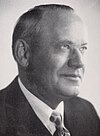| Michigan's 16th congressional district | |
|---|---|
| Obsolete district | |
| Created | 1930 |
| Eliminated | 2000 |
| Years active | 1933–2003 |
This article includes a list of general references, but it lacks sufficient corresponding inline citations .(January 2015) |

Michigan's 16th congressional district is an obsolete United States congressional district in Michigan. It covered the communities of Dearborn, Downriver and Monroe County. [1]
Contents
The first Representative to Congress elected from the 16th district, John Lesinski, Sr., took office in 1933, after reapportionment due to the 1930 census. The district was dissolved following the 2000 census. The last Representative elected from the district, John Dingell, was subsequently elected from the 15th district. The only other Representative elected from the 16th district in its 70 years of existence was John Lesinski, Jr. It could be called a Polish district, because all three district's representatives were Polish-Americans.


